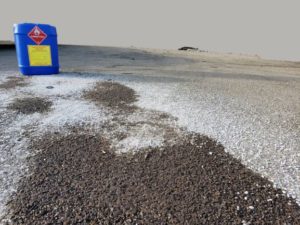Federal regulations of the U.S. Environmental Protection Agency (USEPA) at 40 CFR 262.17(a)(6) require a large quantity generator of hazardous waste (LQG) to comply with the preparedness, prevention, and emergency procedure standards of 40 CFR 262, subpart M. This article is the thirteenth (and final!) in a series that looks closely at each of the sections in subpart M to clearly describe the responsibilities of a LQG.
emergency procedures
The Requirements of 40 CFR 262.265 Emergency Procedures of Contingency Plan for Large Quantity Generator of Hazardous Waste
The Requirements of 40 CFR 262.260 Purpose and Implementation of Contingency Plan for Large Quantity Generator of Hazardous Waste
Federal regulations of the U.S. Environmental Protection Agency (USEPA) at 40 CFR 262.17(a)(6) require a large quantity generator of hazardous waste (LQG) to comply with the preparedness, prevention, and emergency procedure standards of 40 CFR 262, subpart M. This article is the eighth in a series that looks closely at each of the sections in subpart M to clearly describe the responsibilities of a LQG.
The purpose of this article is to address the requirements of 40 CFR 262.260 Purpose and implementation of contingency plan. (more…)

Preparedness, Prevention, and Emergency Procedures for Large Quantity Generator of Hazardous Waste
Both large quantity generators (LQG) and small quantity generators (SQG) of hazardous waste are required by federal regulations of the United States Environmental Protection Agency (USEPA) to take certain measures and have available certain equipment in order to prevent hazardous waste emergencies from occurring and to be prepared to respond to them if they do. In the past the Preparedness and Prevention regulations for both LQG and SQG were the same and were found at 40 CFR 265, subpart C.
 The Generator Improvements Rule made some changes to these regulations.
The Generator Improvements Rule made some changes to these regulations.
- Moved them from their former location for both LQG and SQG to distinct locations for each generator.
- Made several revisions to the regulations applicable to both LQG and SQG.
In an earlier series of articles I identified and explained the requirements of 40 CFR 265, subpart C Preparedness and prevention for a LQG and SQG prior to the Generator Improvements Rule. All of those articles are summarized here. You may also research the requirements of 40 CFR 265, subpart D Contingency plan and emergency procedures (applicable solely to a LQG) here. If your state has not yet adopted the Generator Improvements Rule, then these regulations are still applicable to your facility.
If you are interested in comparing the text of the regulations prior to and after the Generator Improvements Rule, you can view a “crosswalk” of the old to new regulations: Comparison of New and Old Requirements in Generator Improvements Rule: Preparedness, Prevention, and Emergency Procedures for Large Quantity Generators
The purpose of this article is to provide one source for the series of articles I will write identifying and explaining the requirements of 40 CFR 262, subpart M for preparedness, prevention, and emergency procedures of a hazardous waste emergency at a large quantity generator of hazardous waste.
How these regulations apply to a small quantity generator of hazardous waste – found at 40 CFR 262.16(b)(8) – are addressed in this article: Preparedness, Prevention, and Emergency Procedures for Small Quantity Generator of Hazardous Waste
Not sure of your hazardous waste generator status? |
Preparedness, Prevention, and Emergency Procedures for Small Quantity Generator of Hazardous Waste
Both large quantity generators (LQG) and small quantity generators (SQG) of hazardous waste are required by federal regulations of the United States Environmental Protection Agency (USEPA) to take certain measures and have available certain equipment in order to prevent hazardous waste emergencies from occurring and to be prepared to respond to them if they do. In the past the Preparedness and Prevention regulations for both LQG and SQG were the same and were found at 40 CFR 265, subpart C.
 The Generator Improvements Rule made some changes to these regulations.
The Generator Improvements Rule made some changes to these regulations.
- Moved them from their former location for both LQG and SQG to distinct locations for each generator.
- Made several revisions to the regulations applicable to both LQG and SQG.
In an earlier series of articles I identified and explained the requirements of 40 CFR 265, subpart C Preparedness and Prevention for a LQG and SQG prior to the Generator Improvements Rule. All of those articles are summarized here. You may also research the requirements of 40 CFR 265, subpart D Contingency plan and emergency procedures (applicable solely to a LQG) here. If your state has not yet adopted the Generator Improvements Rule, then these regulations are still applicable to your facility.
The purpose of this article is to provide one source for the series of articles I will write identifying and explaining the requirements of 40 CFR 262.16(b)(8) for preparedness and prevention and those of §262.16(b)(9) for emergency procedures at a small quantity generator of hazardous waste.
How these regulations apply to a large quantity generator of hazardous waste – found at 40 CFR 262, subpart M from a referral at §262.17(a)(6) – are addressed in this article: Preparedness, Prevention, and Emergency Procedures for Large Quantity Generator of Hazardous Waste
Not sure of your hazardous waste generator category? |
